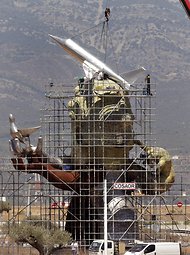By RAPHAEL MINDER
Published: July 18, 2012
MADRID — A plane has finally reached the ghost airport of Castellón, in southeastern Spain.
This statue at an airport in Castellón Province in Spain was supposed to honor an official who is now under investigation.
Rather than sitting on the runway, however, the aircraft, an aluminum model, was placed this week atop a giant statue along the entrance road to the airport — another twist in the tale of a $183 million project that has become a symbol of the wasteful spending that has sunk Spain deep into a recession and a banking crisis.
The statue, 79 feet tall and budgeted at $375,000, was supposed to honor Carlos Fabra, the longstanding head of Castellón’s provincial government and the driving force behind the airport project.
Mr. Fabra was placed under judicial investigation this year in connection with several cases of corruption and tax evasion. He has not been charged, however, and he is not expected to appear in court before the end of the year.
On Saturday, Mr. Fabra formally stepped down as the head of the provincial branch of Spain’s governing Popular Party, which he had run for 22 years. He still maintains the chairmanship of the public company that runs the airport.
Even though the airport has failed to attract a single scheduled flight, Mr. Fabra has staunchly defended his project. In March 2011, when the airport was formally inaugurated, he argued that it would provide a unique opportunity to turn an airport into a tourist attraction, giving visitors full access to the runway and other areas normally kept out of bounds because of safety concerns.
On Saturday, he again described the airport as “a necessary development tool” for his province. Castellón lies in the region of Valencia, which has a debt load of just under $25 billion and a credit rating that was recently downgraded to junk status.
The statue was commissioned by Mr. Fabra and was built by a local sculptor, Juan Ripollés, who titled his work “The Plane Man.” Mr. Ripollés is now saying that he was forced to spend $155,000 of his own money and “empty the pockets of my children” to complete a work that, he said, ended up costing about $600,000.
As part of a decade-long construction and housing boom, Spain added airports, toll roads and railway lines, often under pressure from regional politicians seeking a greater presence within the national transport network. Many of the recently built highways are now deserted, and only one-fifth of Spain’s airports made a profit last year.
Mr. Fabra’s daughter, Andrea, a national lawmaker who also represents the Popular Party, sent a written apology this week to the speaker of Parliament after a defamatory outburst last Wednesday, when Prime Minister Mariano Rajoy presented an $80 billion austerity package, including cuts in unemployment benefits. Ms. Fabra later insisted that her insult was aimed not at the jobless but at the Socialist lawmakers, who later asked for her resignation.
A version of this article appeared in print on July 19, 2012, on page A8 of the New York edition with the headline: In Spain, a Symbol of Ruin At an Airport to Nowhere.


